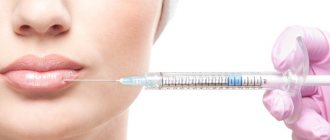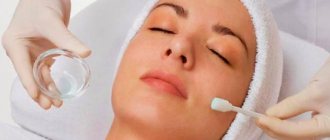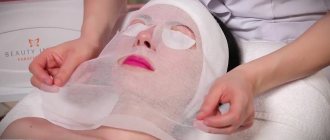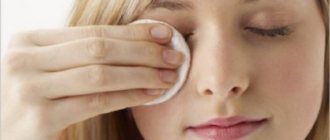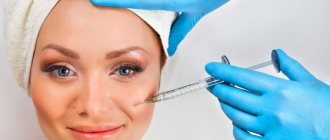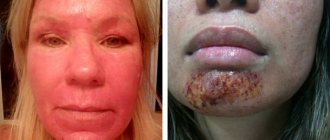With the onset of puberty, the body begins to work in a new way. The hormonal system is also being rebuilt. The sebaceous and sweat glands work more actively. Because of this, pores become clogged much faster than before. An unpleasant shine, acne, and blackheads appear on the skin. To minimize these phenomena during adolescence, the skin needs care. But since the changes have not yet been completed, gentle cleansing is recommended. At this stage, the following cosmetic procedures are suitable for teenagers:
- ultrasonic facial cleansing;
- masks based on natural ingredients;
- light scrubbing.
It is better to use soap- and alcohol-free cleansers to avoid drying out your skin. Cosmetics based on fruit acids have a light exfoliating effect. Various tonics with medicinal herbs have a healing and anti-inflammatory effect. Such care will help remove dead epidermal cells and remove impurities, which will provide renewal, nutrition and hydration.
After 30 years, the skin is already formed. The condition of the skin is affected not only by the internal functioning of the body and atmospheric pollution, but also by stress. Renewal is hampered by the fact that collagen begins to be produced in smaller quantities, and the delivery of nutrients to the deep layers of the dermis worsens due to various blood flow disorders. The skin loses moisture faster, the face becomes less elastic.
At this age, it is possible to use more aggressive types of chemical peeling. Carbon peeling is one such procedure. After it, the face looks significantly fresher and younger, the tone is evened out, and small expression wrinkles are smoothed out.
After 40 years, laser resurfacing and chemical peeling PRX-T33 with a pronounced anti-age effect are recommended.
What does peeling include?
Cosmetic procedures that involve removing the upper keratinized layer of facial skin are called peeling. Removal of “excess” skin can be done at home or in a salon. The life of epidermal cells is accompanied by cycles: birth, development, death. It is the dying layer that women must fight to restore the color and elasticity of the dermis. This does not mean that the keratinized particles need to be removed “cleanly”. The stratum corneum performs a protective function: it protects the face from harmful atmospheric phenomena. If you notice that the skin on your face has become coarsened and rough, it’s time to remove the excess top layer. Delicate facial skin requires careful and measured exfoliation - professional cosmetologists do not recommend performing the procedure frequently. And occasional removal of the stratum corneum will not bring the desired result.
The frequency of procedures depends on the following factors:
- age;
- skin type;
- health status;
- climate and season;
- a method of influencing keratinized cells.
Effect of peeling on facial skin
During peeling, deep cleansing of the epidermis occurs. Its top layer, consisting of keratinized cells, is removed. This accelerates tissue regeneration. As a result, the skin smoothes and becomes younger. Metabolic processes in tissues are normalized, which reduces fat production. Pigmentation lightens and blood circulation increases. Skin tone is evened out.
Scrubs act on the surface of the skin mechanically. They contain hard particles that remove dead horn cells. Chemical components soften the top layer of skin and dissolve deep impurities. The hardware technique removes non-viable cells using ultrasound and laser radiation.
Types of peeling
Learn how to cleanse your facial skin. When and where to carry out cleansing procedures, how often it is recommended to resort to them.
- the mechanical one at home. It includes a gentle physical and very impact on the epidermis: exfoliation using abrasive particles - a scrub. At home, it is permissible to use a scrub twice a week for dry skin types. If you have oily skin, limit yourself to one-time exposure per seven days. Frequent cleansing of the epidermis triggers the production of excess sebum - pores become clogged, acne and comedones form. Normal skin tolerates cleansing better than other types; peeling is indicated as needed. People with combination facial dermis are recommended to clean the problem area once a week. Typically, this is the “T” zone, from which you remove acne, blackheads on the nose and chin. The procedure is suitable for girls during puberty. Do mechanical peeling yourself, starting from the age of 16. This can be episodic care for skin problems. For ladies over 30, professional cosmetologists advise complex and ongoing care, including salon procedures. Read about them below.
- Dermabrasion . A salon procedure during which a special device mechanically “polishes” the skin, visually renewing the upper layer. The cosmetologist selects attachments for the device, depending on the skin type and age of the patient. mechanically, but not manually, but using a special apparatus. Such peeling is done only in a salon, where a cosmetologist operates the device and selects suitable grinding attachments. A professional cosmetologist will also determine the course of treatment, frequency and time of procedures - up to 8 - 10 visits to the salon per month.
- Laser peeling is a hardware procedure for resurfacing the skin with a laser beam. The mechanism of a gentle effect on keratinized cells is launched. The method is used to smooth out scars on the skin, acne marks, and facial redness. After two procedures, the “smooth” effect of the skin is visible. Carry out the procedure with an experienced cosmetologist - the effect will last 4 - 5 years. The redness will go away on the second or third day.
- Ultrasonic exposure. Without traumatic effects on the rough part of the skin, removal of the stratum corneum of the epidermis.
- Vacuum cleaning improves blood circulation in the superficial and deep layers of the epidermis. The result is smooth skin, bright complexion. An experienced cosmetologist will achieve results in 2–3 sessions. You can clean your face with a vacuum yourself by purchasing a special device.
- Cryotherapy is based on exposure to low temperatures. It is familiar to ladies from home procedures: rubbing the face with frozen cubes with particles of coffee, herbal raw materials, green tea. Liquid nitrogen is used in the salon, first the icy cold tightens the pores, then the reverse process occurs. The shock effect on the skin lasts for 3 to 5 minutes in one session. For problem skin or tumors, the cosmetologist will offer you a course of 10–12 procedures with an interval of three days. “Ice burn” removes dead skin cells, the skin of the face becomes red immediately after the procedure. Collagen production is activated and the facial skin becomes elastic and matte.
Mechanical cleaning
Mechanical peeling affects only the surface of the skin, without affecting the deeper layers of the dermis. Therefore, it can be called a relatively gentle process. After such cleaning, the skin is cleansed of atmospheric pollutants and dead particles of the epidermis, which improves the appearance and helps speed up metabolic processes.
Mechanical skin cleaning includes:
- Brossage - this procedure is performed using a device equipped with soft brushes or sponges. Depending on the goal, it is performed with an interval of 7-1 days.
- Peeling scrubs. Recommendations for the frequency of this type of cleansing depend on the oiliness of the skin. For oily skin – weekly; for dry skin, it is recommended to repeat scrubbing every two weeks. After a course of procedures, which lasts 2 months, a break is necessary to avoid the risk of damage from thinning of the upper layers of the dermis.
- Dermabrasion is skin resurfacing. It is performed using a device with special attachments coated with abrasive particles. Most often used for certain problems that require more serious treatment. For example, scars, old scars, deep wrinkles. Breaks between sessions can last up to 6 months, since the surface layer of the epidermis is removed almost completely
- Microdermabrasion. It is also a type of skin polishing, but the treatment is carried out with attachments containing microcrystals. The number of sessions varies from 5 to 20 sessions, and the break between courses is 1-3 months.
A cosmetologist may recommend alternating procedures, since the effectiveness of one type decreases with each subsequent use.
Chemical peeling: benefits and harms
Video: Chemical peeling for the face: what is it, is it harmful, when and how often can it be done
A complex procedure for exposing the skin to acids is popular among women over 40 years of age. The results are close to surgical plastic surgery - a lasting effect of youth throughout the year. Approach chemical peeling responsibly - contact professionals with positive practice - look at reviews of the work of a cosmetologist. The results of those who underwent a “chemical burn” rejuvenation course. This is not a spontaneous negative effect on the skin, but a strictly dosed popular procedure. You must be prepared for the fact that traces of cosmetic intervention will be visible within 2-4 months. Be aware of this before going to a salon for a chemical peel.
HORMONAL SURGELS
Another factor that allows one to indiscriminately attribute harm to facial peels is, of course, pregnancy and similar manifestations of hormonal storms. This is why expectant mothers are not among the favorite patients of cosmetologists. Even when the risk to the fetus is completely excluded, the reaction of the female body against the background of the restructuring of all major life systems is much more difficult to predict.
This is also associated with restrictions on exfoliation during the first phase of the menstrual cycle. It is difficult to accurately predict how the endocrine system will behave, plus a decrease in the pain threshold - all this forces dermatologists to insist on postponing procedures to a safer time. That is, if the scheduled peeling session falls at the beginning of your next period, it is better to postpone it for at least 3 days, so that you don’t have to guess what to expect as a result: harm or benefit.
We recommend: Delight for face and body with MILK PEELING + 3 best recipes
Mechanism of action
The cosmetologist selects an acid that will “dissolve” the skin. The chemical is divided into three groups:
- Fruit acid – malic, citric, tartaric. Indicated for acne, oily skin, age spots.
- Antiseptic – based on drugs: salicylic, benzoic. Indications: acne, oily skin.
- Synthetic: retinoic (analogue of vitamin A), phytic. Used for pronounced age-related changes and pigmentation.
An experienced cosmetologist will prepare acid-based cocktails: add vitamin complexes to the composition, determine the concentration and exposure time to make the procedure as gentle and effective as possible. It will determine the degree of “deep” effect on the skin - it is impossible to avoid the “dissolution” of living cells during chemical peeling, but it is possible to minimize trauma to the epidermis.
Peeling in the salon or at home: pros and cons
So where should you peel: at home or in the salon? It seems to be cheaper at home, and folk remedies can be used. We explain why such a cosmetology initiative is dangerous and why it is better to trust a professional:
1) You can literally “burn” your skin
Peeling is an actual burn of the skin. The degree of this burn is regulated by a cosmetologist: he selects a solution for the skin type and strictly monitors the time of its application. Application technology is also important. Imagine how, due to the carelessness or ignorance of a novice amateur, such a serious procedure can affect the skin: it risks getting burned, and after the burn, scars or scars.
2) A cosmetologist will select an effective course
Can you determine your skin type? Maybe you think it's dry, but in fact it's dehydrated? A cosmetologist will be able to select a peeling for your skin type and its needs, create an optimal course, which may consist of peels of varying depths and strengths, and will monitor the processes of regeneration and restoration - select appropriate home care and give practical recommendations.
3) Folk remedies don’t work
“Creating” acid peeling at home is impossible. Yes, mild AHAs used in superficial peels are often obtained from fruits and berries. But strawberry puree won't actually do anything to your face.
Be careful with folk remedies. They can cause allergies Photo: user18526052 / Freepik
What happens to the skin when exposed to chemicals?
A chemical burn causes redness of the skin, hemorrhage in the epidermal cells, and the formation of a scab. The crust that has formed at the site of damage to the skin will “decorate” your face for up to 15 days. Then erythema will replace it - a sign of a first-degree burn. Depending on the depth of skin damage, individual characteristics, and age, the unaesthetic consequences of chemical peeling can last 2–4 months. Then the skin regeneration process begins. At the site of the burn, new skin appears, radiant with beauty and health.
Hardware cleaning
Hardware peeling is performed using laser or ultrasound. Suitable for correcting even the most sensitive areas. The procedure itself is less traumatic, so the recovery period does not take much time.
This type of peeling can be used with a break of 3-4 months to maintain the achieved result.
Contraindications
Facial skin cleansing by mechanical and hardware methods is not carried out in the following cases:
- exacerbation of herpes infection;
- during infectious diseases;
- with pustular rashes on the face, open wounds;
- elevated temperature.
These are general recommendations for cosmetic procedures. “Acid” exposure has additional limitations:
- pregnancy;
- malignant neoplasms;
- vascular diseases;
- dark complexion;
- allergic reactions;
- warts
If you have the problems listed above, effective anti-aging peeling is not for you. When visiting a cosmetologist, tell us about chronic diseases and medications to which you have an allergic reaction. This will save you from the fatal consequences of deep cleansing of your facial skin.
Summary
A gentle effect on the skin of the face with exfoliation of the upper coarsened layer can be carried out at home weekly. Monitor the behavior of the skin after manipulation and independently regulate the frequency of facial cleansing with scrubs with abrasive particles. Include:
- salt;
- coffee grounds;
- honey;
- chopped apricot kernels;
- Hercules;
- citric acid.
Chemical peeling is not allowed for everyone - the negative consequences of deep acid peeling are great, including the appearance of keloid scars. Carry out the procedure with experienced cosmetologists once a year.
“Fly in the ointment” or the danger of peelings
Despite the wonderful properties of peelings, many people forget, and some cosmetologists simply ignore the information that any exfoliation (especially medium or deep) causes severe injuries to the skin. An artificially caused acid burn of the first degree of severity or mechanical “removal” of the upper layer of the epidermis is a colossal stress for the dermis, causing it serious stress. By activating cell division in the deep basal layer, the skin wastes its resources. The true picture of what happens to the skin as a result of peelings can only be observed under a microscope. The scale of destruction and subsequent cell regeneration make us seriously think about the “benefits” of peelings.
- regular exfoliation thins the skin, causing dryness and increased sensitivity to cold, ultraviolet radiation, wind and some cosmetics;
- Constantly “provoking” cells to artificially divide reduces their lifespan. Peels prematurely waste resources on genetically determined maximum cell renewal;
- Frequent peeling, on the contrary, leads to early aging;
- concentrated acid compositions of chemical peels cause severe swelling, erythema and deep pigmentation;
- Frequent or incorrectly performed acid peels can provoke the appearance of rosacea (vascular network) and the formation of dense scar tissue at the site of exposure to the composition.
Facial peelings, as the main tool for cleansing and rejuvenating the skin, have approximately the same number of pros and cons. Even professional cosmetologists do not have a definite answer to the question about the unambiguous benefits or exceptional harm of exfoliation for facial skin. Therefore, the “golden mean” would be the decision to leave peelings that suit you as a regular maintenance skin care and observe moderation in their use.


